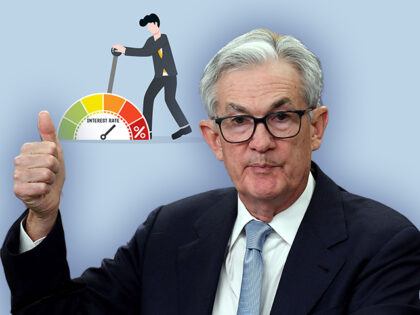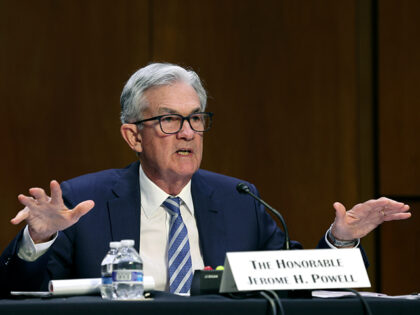Breitbart Business Digest: Trust the Establishment on Jobs
The strength of the U.S. labor market has not only defied expectations. It has given rise to the suspicions that the official figures are overstating job gains.

The strength of the U.S. labor market has not only defied expectations. It has given rise to the suspicions that the official figures are overstating job gains.

In the economic seas we’re currently navigating, the idea of a Fed rate cut is starting to look like a theoretical exercise detached from the practical realities on the ground.

The potential that the Fed’s next move is up instead of down is arguably the most underpriced risk in the market.

Donald Trump’s digital media company is not losing money fast enough.

The job of rebuilding the collapsed Francis Scott Key Bridge in Baltimore is going to take a lot longer than many people initially thought—and cost a lot more money.

The once and possibly future President Donald Trump’s proposal to implement a tariff of ten percent on goods imported into our Republic has been met with a cantillating chorus of critiques claiming they will come at a cruel cost to consumers.

The grand pledge of President Joe Biden “move heaven and earth” to rebuild the Francis Scott Key Bridge smacks of a promise only Herculean in its aspiration.

The economic consequences of the calamity in Baltimore are likely to be substantial.

Shares of Donald Trump’s media startup catapulted a head-spinning nearly 40 percent in just a single trading session on Monday.

The shareholders of Digital World Acquisition Corp on Monday boldly aligned their fortunes with Donald Trump’s Truth Social, ratifying a pact poised to endow the erstwhile and potentially returning commander-in-chief with a bounty verging on $3 billion.

The latest dispatch from the Federal Reserve left the expected path of interest rates over the next year unchanged. Yet it hinted at a potentially tumultuous shift beneath the calm facade, a shift to a higher rate of interest over the long term.

Joe Biden’s recent thumbs down on the Nippon-U.S. Steel marriage was met with the predictable shrieks of “protectionism” from self-styled free-market pundits.

It’s getting harder each day to avoid the conclusion that the Federal Reserve’s supposedly tight leash on the economy might be more of a myth than a reality.

Despite the Fed’s belief that monetary policy is restrictive, the U.S. economy was frolicking along at a robust four percent growth rate in the latter half of the previous annum.

Perhaps some of the courage of the patron saint of Ireland will inspire our central bankers.

Immigration is not going to bail America out of our inflation mess.

President Joe Biden’s attempt to convince America that Bidenomics is a blessing is not working —especially among younger Americans.

Inflation is re-igniting, and there is a danger of significant overheating. This should keep the Fed from cutting interest rates in June or July—and very likely for the rest of the year.

Last week’s inconclusive jobs data means that this week’s inflation data has the potential to be very consequential.

The February jobs numbers should be seen as an economic Rorschach test. What you see in the ink blots released by the Department of Labor largely depends on what you were already inclined to see.

Perhaps the biggest challenge for Biden’s attempt to sell Americans on Bidenomics is not just that the inflation-inflicted wounds of the last few years are still fresh. It’s that they can remember that things were better when Trump was president.

Fed Chair Jerome Powell pointedly declined to defend the establishment view that immigration is a boon for the economy and more immigration even better.

The American economy finds itself awash in the newfound bloom of economic springtime.

When Jerome Powell steps into the congressional coliseum to deliver his semi-annual testimony to the House and Senate, he is very likely to be met with an aggrieved chorus of Democratic lawmakers arguing that monetary loosening is long overdue.

George Eliot’s short story “Brother Jacob” begins with a warning about the danger of the desire to be a provider of sweets. It’s a warning about inflation

Inflation is rising, and the underlying indicators of price pressures suggest this is unlikely to reverse soon.

The economy did not grow quite as fast as previously thought in the third quarter, but the details should undermine any hopes that this might allow for earlier or deeper rate cuts from the Federal Reserve this year.

There is clearly a partisan component to consumer attitudes about current economic conditions.

The manufacturing sector is hitting a note that’s been sorely missed in recent acts: the sound of recovery.

Fed Governor Christopher Waller argues that there is no reason to fear that we are sailing into a recession, which is the thing that usually prompts rate cuts from the Fed.

Nvidia has been described as the manufacturer of sieves, shovels, and pickaxes for the artificial intelligence gold rush. But what happens if the artificial intelligence boom goes bust?

The decision of the Fed to start cutting interest rates bears a strong resemblance to the decision to marry. It can be reversed but only with a great deal of awkwardness, some economic difficulty, and often a reputational cost.

The anticipated economic chill prompting rate cuts seems to be thawing before our very eyes.

The disinflationary forces that convinced so many that we were marching into a period of easing have receded. When Wall Street will recognize the pattern on the wall is still an open question.

We are in serious danger of entering a historically anomalous era of prolonged inflation.

The evidence is mounting, as solid and as undeniable as the ground beneath our feet. Inflation is here, it’s real, and it’s time to pay attention.

Inflation, having long since overstayed its welcome, announced on Tuesday that it was just getting comfortable.

The Federal Reserve justifiably received a lot of criticism for its tardy response to the surge of inflation. Now its critics accuse it of being too hesitant to lower interest rates.

Monetary policy may be a dead end. Perhaps it’s time to start looking elsewhere for what is really driving inflation and growth.

The economy appears to be able to operate at a high rate of growth with interest rates that would have been seen as highly restrictive in the pre-pandemic era.
